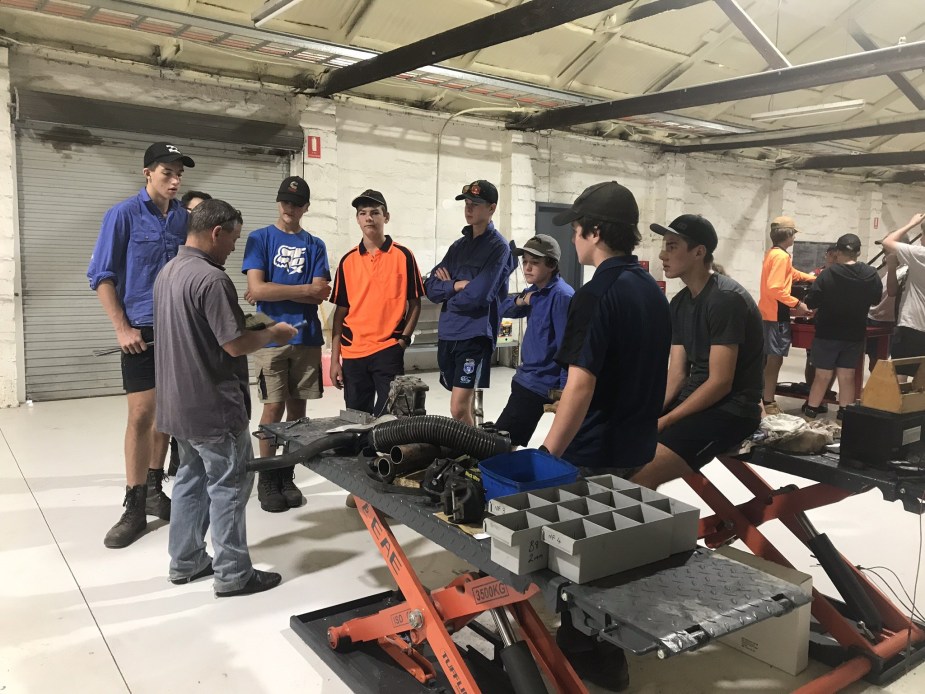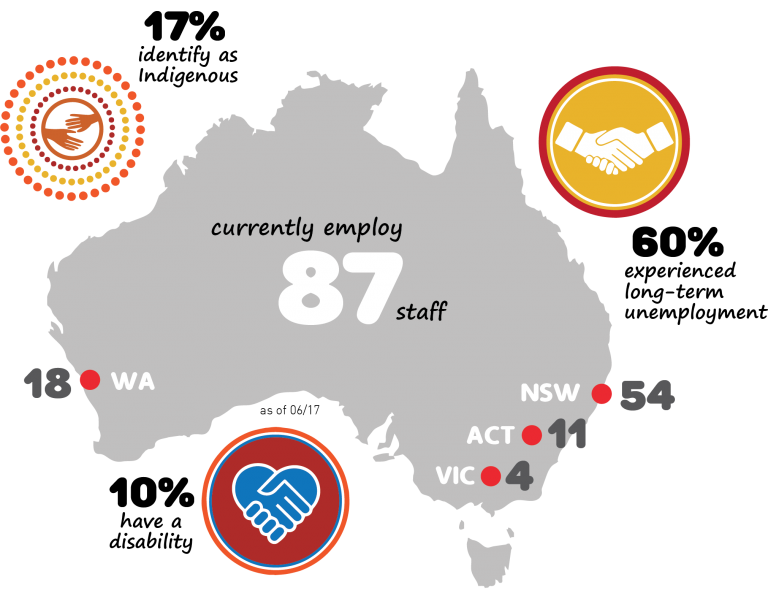Volume 28, Issue 1, March 2020
Volume 28, Issue 1, March 2020
Rachel O’Neill, Head Teacher HSIE, Newtown High School of the Performing Arts
This article examines the rise of social enterprises in Australia. It identifies what a social enterprise is, looks at the roles, goals and stakeholders of businesses in Australia and then focuses on the specific contexts of social enterprises. It provides three short case studies of social enterprises which students can then investigate in more detail, and finally looks briefly to the future of social enterprise in Australia.
Social enterprises are businesses that trade to intentionally tackle social problems, improve communities, provide access to employment and training, or help the environment. Social enterprises:
Have as their main goal an economic, social, cultural or environmental mission to create a public or community benefit, as opposed to private interest (profit)
Are best defined in terms of social purpose, not legal structure
Trade to fulfil their mission and derive a substantial portion of their income from trade
Reinvest the majority of their profit/surplus in the fulfilment of their mission
Are owned and run by community organisations and charities, and generally have links other community organisations.
Businesses play a number of roles in the economy and society, including the following:
Creating profit for owners, which is the number one goal of most businesses and is achieved by maximising the difference between sales revenue and costs.
Providing employment to people through which they can earn income, develop skills through training, mentoring and experience, potentially gain promotion and career development, create friendships, as well as income security which enables people to feel empowered in their lives and to be able to borrow or save for future purposes such as buying a home or retirement.
Providing income to owners through profits including dividends to shareholders of companies; and to employees in the form of wages and salaries, and superannuation.
Providing choice for consumers and other businesses who can purchase a wide variety of goods and services from competing businesses.
Innovation through developing new products and production techniques that reduce prices, increase the range of goods and services available, enhance customer satisfaction, and assist community development and environmental improvements.
Entrepreneurship whereby business owners take risks in establishing new businesses, expanding existing ones, and creating businesses that can take the economy and society into new directions.
Creation of wealth whereby business owners, investors and wage & salary earners can use their income to purchase assets to grow personal wealth; and where tax paid by businesses enables governments to accumulate national wealth investing in public assets such as schools, transport systems and national parks.
Quality of life, where businesses improve people’s lives through employment, goods and services, enhancing natural and physical environments, and providing opportunities to accumulate wealth and to live in vibrant communities.
The function of every business is to produce goods and/or services to sell to customers. In terms of business goals, these can be divided into two main categories: financial and non-financial goals.
Financial goals pertain to money. The main financial goal is to generate profit – every other financial goal is ultimately directed towards this goal. Other examples of financial goals include business expansion, increased market share and increased share price.
Non-financial goals are directed towards social and/or environmental issues. Examples of social goals could include supporting migrant communities and refugees, employing people with disabilities, or contributing to a community. Environmental goals include minimising waste and other forms of pollution and promoting sustainability.
For a social enterprise, while financial goals such as minimising costs and increasing sales are important in ensuring the ongoing success of the business, the ultimate long-term goals are social goals.
A social enterprise will aim to generate ‘profit’ (revenue exceeding costs), in order to fund the operations of their social mission and to reinvest into activities that deliver on this – not for individuals but for the good of society.
Stakeholders are individuals or groups who have an impact on the business, and who are affected by and have an interest in the activities and performance of the business.
Examples of stakeholders for a typical business include:
Stakeholders are individuals or groups who have an impact on the business, and who are affected by and have an interest in the activities and performance of the business.
employees from disadvantaged backgrounds or from the local community,
individuals and households in a local community who need specific services,
local government and non-government organisations who sponsor or work with the social enterprise
supporters who offer resources and support to the social enterprise, such as providing finance, supplies/materials, sponsorship or influencers who recommend and promote the enterprise
volunteers who do unpaid work for the business
the local or wider natural environment
Social enterprises play an important role in providing services, encouraging economic participation and driving social innovation. While data on social enterprises in Australia is not comprehensive, research to date tells us that
There are around 20 000 social enterprises in Australia
In terms of business size, 73% are small businesses, 23% medium and 4% large
In terms of legal structure, 33% are incorporated associations, 32% are companies limited by guarantee, and 18% are proprietary limited companies
They operate in all sectors of the economy but are mainly found in the services sector (68%) with the largest groups being retail and healthcare
35% target people with disabilities, 33% target youth and 28% target disadvantaged women
Their growth is mostly driven by demand from local and state governments, and some large corporations such as Westpac
They employ twice as many Australians with disabilities and female managers than other small businesses
They are more likely to employ the long term unemployed
Nationally, income earned from operations accounts for approximately 85% of their total income
They rely on a combination of paid and volunteer workers and ‘in-kind’ (non-monetary) contributions
They operate mostly in local markets, but some trade internationally
Corryong is a country town in north-eastern Victoria with a population of 1345. Many rural communities, including Corryong, struggle to retain people due to lack of job opportunities. School leavers, for example, often leave town immediately due to lack of jobs. The labour force participation rate is 49%, much lower than the national rate of 66%, with household income at 63% of the national average. The Corryong Neighbourhood Centre (CNC) is a not-for-profit community organisation. Their long term goal is to provide funds across the community to support employment, education, sustainability & growth.

Figure 1: Corryong map. Source:http://www.murrayriver.com.au/ corryong/
The Corryong Neighbourhood Centre (CNC) in north eastern Victoria runs two social enterprises: The Upper Murray Community Bakery (UMCB) and Upper Murray Community Garage (UMCG). The CNC runs these social enterprises in order to provide employment and training opportunities for people living in Corryong, linked with a broader goal of sustaining and growing this rural community.
These enterprises generate revenue needed for the Neighbourhood Centre to fund its other activities such as their Youth Program – 61% of the CNC’s revenue comes from self-generated income including earnings from their social enterprises (other funding sources include government grants, donations and loans). Ultimately, when all the debt is repaid and both businesses are generating profits, surplus funds (over and above what it costs to operate the CNC) will be donated to the Upper Murray Innovation Foundation (UMIF). The UMIF provides facilities, funding and assistance for learning and skills development for people in need of direct support to find their way back to integration into the community – for example a bus to ensure affordable transport for the community, and investment finance for social enterprises.



Figure 2: Upper Murray Community Garage; Figure 3: Youth training at UMCG; Figure 4: UMCB Donuts
The contributions of these social enterprises include:
Providing jobs which give people meaningful work, income, training and development opportunities plus the other benefits associated with employment
Enhancing connection and cohesion in the community
Retention of school leavers and others who might otherwise leave the community in search of employment elsewhere
Attracting some people to move back to the town who previously left to find work
Providing services to people in the community, such as mechanical repairs, making life more convenient and bringing vibrancy to the community
Generating revenue that is used to finance the activities of the CNC including youth programs and seniors’ programs
Demonstrating a sustainable business and community model that will potentially inspire people to create their own businesses
The Social Outfit is a social enterprise based in Newtown, Sydney. It is a fashion label that includes a clothing retail store with onsite manufacturing as well as a sewing school, providing newly arrived migrants and refugees with employment and training in retail, manufacturing and design. The activities of The Social Outfit are divided into operational activities (70% of the time) and education, training and social programs (30%). Operational activities include the workroom where products are made and the retail store where products are sold; they also have an online store. They are a registered charity and have connections with a range of community organisations such as Asylum Seekers Centre and Settlement Services International (SSI).
The social purpose of this business is to assist people who are refugees and newly arrived migrants, by providing employment and income, building skills and so leading to empowerment and social inclusion. The business is accredited by Ethical Clothing Australia.

They use sustainably and ethically sourced materials, creating and selling unique products to customers while providing a service that educates customers about the human stories behind their products and business. This celebrates multicultural Australia while building social cohesion. They also have a positive environmental impact, incorporating donated excess fabric from fashion industry partners in their collections, and have saved over 5 tons of fabric from landfill to date. Profits are reinvested into the business to further pursue their social goals.
Social Outfit employs refugees and newly arrived migrant women and young people in order to help them:
Develop the experience and skills to become work ready
Develop goals for the future and create a sense of empowerment
Develop a sense of belonging and purpose within their community
Form social connections and transform their lives
Use their cultural strengths and skills, e.g. dressmaking and design
Soft Landing is a social enterprise established in the Illawarra region of NSW which operates across Australia. Their core operations involve diverting waste from landfill by working with councils to collect discarded mattresses and beds including from illegal dumping, and recover their components such as metals, foam and timber for recycling.

Soft Landing identify their four key objectives as follows:
Provide employment and training
Protect the environment
Support our community
Sustainability
The main goal of this business is to reduce the environmental impact of waste. For example, mattress springs are sent to manufacturers who use it to create new steel; mattress foam is cleaned and used as carpet underlay, and fabric can be turned into mulch and animal bedding. Every 10 tonnes of materials equates to taking four cars off the road permanently or providing more than 14 homes with electricity for a year.
In addition to their environmental mission, this business believes that they can contribute to safer, productive communities by providing secure employment and training to improve people’s economic well-being, physical and mental health. They employ people who have previously faced barriers to secure employment, particularly the long term unemployed.
Employees of this business have benefited not only from the work and income provided through their employment, but from access to training to gain qualifications in Business and Waste Management, and in some cases to progress into management positions within the business.
Research in 2019 from Impact Boom, a social enterprise that works to assist social entrepreneurs and their communities in Australia and globally, points to the need for more coordinated government support and the development of a national social enterprise strategy. This research identifies the Victorian government as a leader in this area, along with some local governments in Victoria, NSW (e.g. Parramatta City Council) and Queensland (e.g. Brisbane City Council) that have created social enterprise strategies.
Another significant challenge for social enterprise is the ability to attract capital finance. The CEO of StartSomeGood, a crowdfunding platform for social enterprises, believes that what the sector needs is ‘impact angels’. Impact angels are investors who are prepared to take a greater risk with their money in order to finance businesses for social purposes, and so can play a greater role in promoting innovation in the social enterprise sector into the future.
Literacy/ vocabulary
Ready to Read
Before attempting the questions in this article, it’s a good idea to get ‘ready to read’: Skim through the article to get an overall impression of what it’s about; scan the article again to find important and relevant terms and concepts, highlight these terms; create a vocabulary list of terms and meanings using a Business glossary or dictionary. Now, you’re ready to read!
Definitions
Define these terms used throughout the article in their correct business context.
(You may need to research business dictionaries to find some of these definitions)
Social enterprise, profit, dividends, incorporated association, company limited by guarantee, proprietary limited company, labour force participation rate, ethical, impact angel.
Questions
1. Write a paragraph outlining the various roles of business in Australia. 2. Draw a table showing financial goals and non-financial goals of business. 3. Create a mindmap of the typical stakeholders of social enterprises. 4. Construct an infographic or poster illustrating the roles of social enterprises in Australia. 5. Distinguish between social enterprises and other, profit orientated businesses with reference to examples. 6. Explain how the social enterprises run by the Corryong Neighbourhood Centre can contribute to the local community. Go to the CNC’s website for extra information at https://corryongnc.org/ 7. Go to The Social Outfit’s website at https://thesocialoutfit.org/. Look through the website, with particular focus on ‘About Us’, and ‘Projects’. Write a one page business report in in which you:identify the goals of this social enterprise,
outline the roles of its team members,
explain the importance of links with other organisations using examples, and
evaluate the impacts of this social enterprise on the people it employs and trains with reference to specific people/ examples.
Thank you to Sara Jenkins from Corryong Neighbourhood Centre, Camilla Schippa from The Social Outfit and Amanda Henderson from Soft Landing, for information as well as images provided/permitted for use and for their commitment to using business for community and public benefit.
Tom Allen, The State of Impact in Australia; How Social Enterprise Momentum is Gaining, 5/12/2019, <https://www.impactboom.org/blog/2019/8/4/the-state-of-impact-in-australia-how-social-enterprise-momentum-is-gaining>
Jo Barraket et al, Map for Impact: the Victorian Social Enterprise Mapping Project, November 2017, commissioned by the State Government of Victoria, <https://mapforimpact.com.au/wp-content/uploads/2017/11/Map-for-Impact-FINAL-REPORT_2.pdf>
Jo Barraket, Nick Collyer, Matt O’Connor and Heather Anderson, Australian Centre for Philanthropy and Nonprofit Studies June 2010, Finding Australia’s Social Enterprise Sector, found at <https://www.socialtraders.com.au/wp-content/uploads/2016/07/FASES-2010-full-report.pdf >
Erin Castellas and Jo Barraket, 4/12/2017, How social enterprises are building a more inclusive Australian economy, <https://theconversation.com/how-social-enterprises-are-building-a-more-inclusive-australian-economy-88472>
Centre for Social Impact, accessed 1/2/2020, <https://www.csi.edu.au/
https://www.thesocialstudio.org/ >
City of Parramatta Council, accessed 15/2/2020, <https://www.cityofparramatta.nsw.go.au/business-development/social-enterprise>
Corryong Neighbourhood Centre, Annual Report, 2018: <https://corryongnc.org/wp-content/uploads/2019/01/2018-annual-report-for-email2.pdf>
Corryong Upper Murray Community Bakery, accessed 1/2/2020, <https://corryongnc.org/upper-murray-community-bakery/>
Corryong Upper Murray Community Garage, accessed 1/2/2020, <https://corryongnc.org/upper-murray-community-garage/>
https://www.abc.net.au/news/2018-09-12/social-enterprise-paying-off-for-regional-areas/10236884
Inaugural social enterprise business award winner, Inner West Council NSW, accessed 29/2/2020, <https://www.innerwest.nsw.gov.au/about/news/media-releases/2019-media-releases/-social-enterprise-business-award-winner>
Alan Kay, 1/5/2019, The importance of ownership in understanding social enterprise, <https://probonoaustralia.com.au/news/2019/05/the-importance-of-ownership-in-understanding-social-enterprise/>, accessed 22/2/20
Queensland Social Enterprise Council, accessed 15/2/2020, <https://www.qsec.org.au/>
Davide Schiappapietra, 24/11/2019, The fashion label giving refugee women their first job opportunity in Australia, found at <https://www.sbs.com.au/news/the-fashion-label-giving-refugee-women-their-first-job-opportunity-in-australia>
Smith, Fiona, 23/6/17, Better bedfellows: how social enterprise momentum is gaining, <https://www.theguardian.com/sustainable-business/2017/jun/23/better-bedfellows-how-mattress-manufacturers-are-stopping-the-waste>
Author unknown, Finding Australia’s Social Enterprise Sector 2016, Social Traders and the Centre for Social Impact Swinburne, founds at <https://www.socialtraders.com.au/wp-content/uploads/2018/02/Fases-2016.pdf>
Social Traders, What is a social enterprise?, accessed 15/2/2020, <https://www.socialtraders.com.au/about-social-enterprise/what-is-a-social-enterprise/social-enterprise-definition/>
The Social Outfit, accessed 1/2/2020, <https://thesocialoutfit.org/>
Soft Landing, accessed 21/2/20 <https://www.softlanding.com.au/>
StartSomeGood, accessed 15/2/2020, <https://startsomegood.com/>
Sarah Stevenson, 12/09/2011, LearningfromWOeRK Project, Plymouth University, accessed 15/2/2020, found at <https://www.youtube.com/watch?v=WjxvP5eitzk>